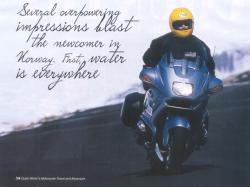
We had stopped to take a few pictures in a small village with a beautiful town square. "Two meters," said Jorge Botto to his son as the statuesque blonde walked by with long, athletic strides. "Ah, si, al menos dos metros (Ah, yes, at least two meters)," replied his son wistfully. I had been hearing this chatter about "two meters" for five days from the Bottos father-and-son team from Guatemala, and it finally got the better of me. "What the hell are you guys talking about?" I asked. "What's with the two meters?” Their explanation was perfectly logical, based on their standards of beauty. If a woman is two meters (just over six feet) in altitude, the boys like them. Since neither Botto is taller than 5-foot-8, anyone two meters in height towers over them. One can only imagine how spectacular these Viking Warrior Queens must look to them.
The women aren't the only stunning scenery in Norway. At least that was what Rob Beach, owner and CEO of Beach’s Motorcycle Adventures (716/773-4960), told me prior to this trip. He claimed that the riding and scenery in Norway at the very least equaled, and most of the time surpassed, that of Switzerland and Austria. Having spent quite a bit of time riding in those locations, I was a little skeptical. "Not only is the overall touring there as good or better than it is in the Alps," said Beach, "I guarantee you that certain parts of Norway are more spectacular than anywhere you've ever been."
Well, that did it. Two weeks later, staff photographer Brian Blades and I were in Kristiansand, Norway, signing the papers for our rental bikes.
"Welcome to the Trail of the Trolls," bubbled Per Bendixen, our Teutonic tour guide. "If this is your first visit to Norway, you're going to have a great time." As we rolled the bikes out of the garage, I noticed that the smiling Bendixen was in such good shape that he could be a mountain-climbing instructor or even a downhill ski racer. He and the other Norwegians in the shop were muscular, tall, lean and tidy.
"Damn," I whispered to Brian, "compared to these people, I feel fat, sloppy and grouchy."
"That's because you are fat, sloppy and grouchy," he said quietly, and kept on writing. Well, I did feel like a troll.
That evening, around a royal banquet at the Quality Hotel Kristiansand Sorlandsparken, we received standard issue maps, tour books, markers and various accessories, and got acquainted with our fellow travelers. Aside from the Bottos, there was Stuart Boulter, a lawyer from Colorado; a shadowy character named David Hessell from North Carolina; Joan Horst from New Jersey, who works for BMW America and rides like the wind; Andy Hyde from Connecticut; David Morris, a diaper designer from Venezuela; James and Janice Mulvany, the eternal honeymooners from Colorado; and David and Lisa Newswanger from Pennsylvania. Counting guides, Brian and me there were fourteen people on the tour, which is just about perfect -- big enough for variety, small enough to build friendships.
I had chosen a BMW R850C Custom for the tour and, for the most part, it proved to be a wise choice. The seating position accommodated my bulk nicely and the handling is well within the parameters required for world-class sightseeing. All it really needed was a bit more power. The 850 is a smaller-displacement, European-market version of the R1200C sold in the States, and that bigger motor would have been nice, especially in the mountains that we headed for on the first morning.
The inaugural day of any tour is wonderful, but it is especially good when you're in a country for the first time and the weather is great. And our launch-day weather was absolutely perfect. We departed Kristiansand and pointed the bikes toward Telemark country.
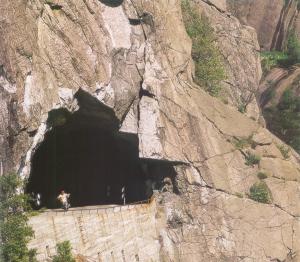
Numerous overpowering impressions blast the newcomer in Norway. First, water is everywhere. In one direction is the North Sea, and at all other compass points are untold thousands of lakes, ponds, fjords, rivers, streams, waterways, channels, rivulets, canals, brooks, ditches, conduits and aqueducts. The food swims in it, transportation floats in it, the Vikings fought in it and the tourists dig it. It shapes the national identity, powers the electricity, and the bathrooms come alive with the sound of water. Taking a shower in Norway is like standing under a fire hose, more savage than a Swedish massage. The water pounds on your head and shoulders mercilessly until you stagger to bed, battered into submission.
And the toilets! The water blasts into the circular porcelain abyss with such violence that even the worst insult instantly disappears. So powerful are the toilets that you can stand anywhere in the bathroom as one flushes, and the breeze created by the water rushing out of the bowl whispers by the ear. American toilets, once the pride of the world but now shackled with wimpy tank-capacity limits imposed by misguided environmentalists, are shamed by the happy, roaring Norwegian bathrooms.
The second impression is that all Norwegians, if not wealthy, are at least doing pretty well. This was reinforced by a young German girl I spoke with named Julia Hagemann, a high-school exchange student from Munich. I asked how she liked her stay in Norway and she said, unabashedly, "The people here are very rich. I know this for sure because we in Germany are rich, and Norwegians are really rich. Everyone here has at least one computer and two TVs and two cars."
That wealth comes from beneath the North Sea. Norway is the world's second-largest exporter of oil, bested only by Saudi Arabia. Norway's constitutional monarch government distributes the wealth from the black stuff to the country's 4.4 million citizens - which ranks the country among the most sparsely populated in the world.
Norwegians are a modest bunch without a strand of ostentation in their DNA. They all drive new cars, but you get the sense that they wish those cars looked used, so the neighbors won't think them uppity. The houses are neat and tidy, but there is no such thing as architectural diversity. There are old wooden (log) houses with sod roofs, or there are new wooden houses with sod-roofed garages. New or old, they're all the same, and by American standards, so are the people. There’s lots of white folk of Nordic descent plus about 75,000 immigrant workers who are kept under close tabs.
Third, everyone seems to be happy. Maybe this was because we were there in June, just as blinking Norwegians are emerging from a long winter hibernation and are lavished with sunlight 20 hours a day. And it doesn’t hurt that Norway has one of the world’s shortest work weeks – 37 hours. Maybe it’s because the place is so peaceful and quiet – horn honking is illegal except for emergencies. Or is it that the human development index (infant mortality, lifespan, employment, national income, etc.) is the second-highest in the world? Hard to say. But at every opportunity for a temper flareup, such as a traffic peccadillo, they merely smile, wave, and go on their merry way.
Fourth, everyone speaks English. Sure, they may sound like Minnesotans, but their English vocabulary is broad and they try hard at using it well. There is absolutely no language barrier in Norway for anyone who speaks English.
There is, however, one very endearing quirk of the Norwegian dialect: a tiny, quick inhale, as if from a small splash of cold water on the face, used as a device of agreement. Instead of saying “yes,” they inhale quickly in a shallow half-breath. When employed by men, it’s merely curious. When used by ladies, it’s sexy to the point of distraction.
Columnist George Will once opined that there is very little perfection in the world, but that he thought Switzerland is the perfect country. I disagree mightily, it’s Norway.
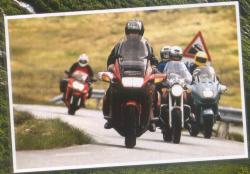
Our first day’s ride was planned as a gentle jaunt to get everyone comfortable with Norway’s roads, road signs and ground rules. Ground Rule Number One: There are no shoulders on the backroads. You’re either riding on the road or motorcrossing through a forest or doing the backstroke in a lake or river. Most mountain roads are only nine feet wide; so, with the combination of no shoulders and narrow roads, tour buses and trucks make precision riding mandatory.
Ground Rule Number Two: Everything in Norway is excruciatingly and painfully in order. No litter, no graffiti, and everything works. Order is the order of the day – and of life. There are upsides and downsides to that sort of personal structure and work ethic. Houses and food there too bland for you? Get over it, because everything works. Personalities and appearance of everyone the same? Get over it, because everything works.
It's also clear that Norwegians do not abide bad behavior. If you get caught exceeding the speed limit by more than 40 percent, they'll confiscate your license and send you home. Get caught packing more than .05 percent blood alcohol and they'll confiscate your license and send you home. Cross a double or single solid line and you'll pay a fine of over $200, then lose your license, at which time you might as well go home.
I asked one of the guides if all of Norway was that rigid, and he said, "Look about the town square here. Do you see any children throwing tantrums or crying? Have you heard anyone yell across the square, or even talk loudly?" Funny he would mention that, because I had noticed that the children were amazingly quiet and respectful and the adults were very mature. Even the teenagers acted, well, human. "No," I said, "Everything is peaceful."
"Discipline," he said with a smile. "It's our way. If you cannot discipline yourself to use manners and be peaceful, the police will assist you."
I was a little offput by this concept, which is so foreign to the American temperament, until I learned about the steadfastness of Norway's populace during their occupation by Germany in WWII. With their underground guerilla operations, the Norwegians proved to be so much of a pain in Hitler's ass that it took over 400,000 German troops garrisoned in Norway to keep them under control. That works out to about 1 armed German soldier for every 10 unarmed Norwegians. Keeping so many of the enemy away from the front was a major Norwegian contribution during the war. Discipline indeed.
We stopped for an outdoor lunch at a sidewalk cafe in the town of Kviteseid and - accompanied by the frequent cry of "two meters" - ate our kippers and watched the locals walk by. It was about then we noticed that most every restaurant has a statue of a troll at the entrance or standing guard near the cash register. I asked an elderly gentleman sitting at the next table why all the trolls, and why some are malevolent and some are as cute as Sleepy, Dopey and Doc.
"When I was young," he said with a sad face, "my parents told us scary stories of terrible trolls who would carry us off if we wandered out into the woods alone or played under the bridges. Trolls were a device to keep kids safe, and they became a part of our folklore and our identity. We were known for our fearsome trolls." He stopped momentarily to drain his glass of beer before continuing. "But now the politically correct or the touchy-feely or the image-conscious or whatever you want to call them – idiots - have decided that trolls are bad for our children's psyche and bad for our country's image. So now, part of our heritage has been sacrificed on the altar of self esteem." As we were departing for the afternoon's ride, I told him not to feel so bad; America has been dealing with that crap for years.
When we pulled into the Gran Hotel Borkbsjo Notodden that evening, our bags had already been laid out in our beautiful rooms. After we all were sufficiently pummeled by fierce showers, we descended to the dining room for a repast of fish.
Now, let us speak plainly about the Norwegian diet. Being blessed with endless water both salty and fresh, they're equally blessed with lots of fish, both salty and fresh ... and fricasseed, pureed, fried, pickled, smoked and lye-dried. They've got haddock and tuna and smelt and sardines. They've got red snapper, whitefish, grouper, trout, perch and blowfish. They've got octopus and squid.
They've got fish floating in warn milk and trapped in gelatin. Barbequed and curried. Hot and cold. Poached, boiled and grilled. They've got it for breakfast and dinner, winter and summer. It's in the shop windows, in tin cans, on the street, up your alley, in the movie theaters and swimming in the fjord fish farms.
What I'm trying to say here is that these folks eat a lot of fish. Certainly more fish than I was ready for. But then again, Norwegians all look so ... so healthy!
Bright and early the next morning, we were back on the roads, all of which got better and better over the next three days. The Norwegian guide book uses the word "serpentine" a lot when referring to the country's roads, and it's an accurate description. The roads twist through endless miles of waterfalls, spring grass and flowers. I have to admit that Rob Beach was right: The scenery is every bit as beautiful as any I'd seen anywhere in the world. We'd had to endure rain, fog and snowdrifts to get to it, but the scenery was well worth the effort.
After five days on the road, we finally got to the fjords, where the tour took on an entirely different texture. Previously, the scenery had been merely beautiful, but it now shifted into hyper-drive. We lounged on ferry top decks, ate sardine snacks and watched waterfalls cascading in seemingly slow motion to the riled ocean fingers below.
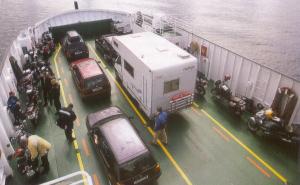
We took a ferry ride all through the Sognefjord, which is best described by that same guide book: "Not only is the Sognefjord the world's deepest fjord at almost 4000 feet, and longest at 126 miles, but it must also be one of the narrowest - less than 300 yards wide in some places. The surrounding mountains, some of which rise more than 5000 feet, literally tower over the ferry, which almost disappears between them. The vertical cliffs are draped with several wonderful waterfalls. The experience is truly neck breaking." As colorful as that description is, it falls short of the crisp, fresh reality.
We got back on the bikes and rode out of the town of Fagernes, starting at sea level and climbing up into the Jotunheimen Mountains. It is the highest mountain range in Norway, and it was still covered with snow. Lots of snow. In some places on the road, the carved-out drifts were way above head level. And it was downright cold. Brian and I were thankful that the sun was shining, or else the temperature would have been well below freezing.
Next day, on our way to the lovely city of Bergen, we crossed the Sognefjell Pass, the highest in Norway. Before the road had been completed and the first car chugged over it, the Sognefjell was the major route for Norwegian traders. Historical records report that in 1878, more than 16,000 travelers braved the road, utilizing 1350 horses with sleds, 820 packhorses and 488 unfettered horses. In the dark.
Apparently, Norwegians have gotten softer, because nowadays, the road is closed to all traffic in winter. That night, we landed in Bergen.
According to the guide book, Bergen at night is the loveliest cityscape in all of Northern Europe. I haven't been to every city in Northern Europe at night, but I have to admit that Bergen after dark indeed is beautiful. It also offers an abundance of museums and historical sites, including many of the old stave churches that eased Norwegian architecture from paganism into Christianity.
Brian and I, along with the Bottos, strolled around the city center admiring the local scenery. Brian and I focused on the architecture while the Bottos were more caught up with subjects worthy of their exclamations of a certain metric dimension. A taxi driver asked why the Bottos occasionally called out their two-meter song, and when we explained, he thought for a moment and then expanded on the Bottos' observations.
"It's true," he said in genuine bewilderment. "Our women are getting taller, and I don't know why. I started noticing it about 15 years ago, and I like it. Except, at the same time, I noticed that our men are staying the same height." He paused for a moment, then said with a huge grin, "But damn, boys, they're beautiful, no? If you want a beautiful woman, go to Oslo and find one. They have very strong teeth." We thanked him and promised we'd, umm, look into it.
The next day, our tour of the Fjord region climaxed with the ascent up to the Lysbotn summit. We disembarked at the base of the summit after a four hour ferry ride, then screamed up the excruciatingly tight, twisted turns to the top of the mountain, then turned around and rode back down. Then rode back up again.
After our last ascent, we paused to snap some photos at the top of the mountain, which surveys unspeakably gorgeous scenery. This trip marked the seventeenth time I've traipsed 'round Europe on a motorcycle, and I can say without hesitation that the Lysbotn Road is the most spectacular I've ever ridden. Period. Other mountain passes in the Alpen region of Europe have been close - Grossglockner Pass, Furka Pass and the Dolomite region are all fine riding roads with outstanding scenery. But none of them can match the sights from the Lysbotn with the mountains on the right and the fjord on the left.
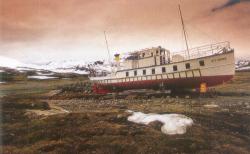
That experience came on the penultimate day of our tour. On the very last day, we celebrated the end of the ride in high style back at the Quality Hotel in Kristiansand.
In my opinion, it is impossible to grade any country as a motorcycle touring destination; such evaluations tend to be much too subjective. Besides, one gathers from a tour in large measure what one brings to it. But if a country could be graded, I'm pretty certain that Norway would rank in the top two for just about everyone.
It is possible to grade a tour company, however, and on that score, I give four stars and two thumbs-up to Beach's Motorcycle Adventures and its Scandinavian contractee, Nordic Bike Tours, for their Trail of the Trolls tour. Every aspect of the trip was carried out to perfection. The hotels were first-class, the bikes worked flawlessly and the preparation was impeccable. And the tour guides themselves were patient, informative, great riders and eager to show off their remarkable country.
I can think of nothing I would change or even suggest. It was a perfect tour in a perfect country.
